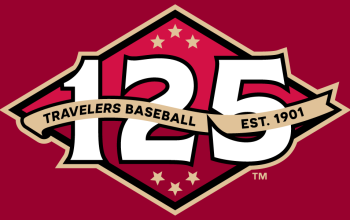Let’s be honest, of all the sharks out there in the world, hammerheads are one of the few that can be described as goofy looking. They have tiny mouths under their big, crazy noggins (technically called cephalofoils), which they use to stun and pin prey like stingrays, octopus, and shellfish as they skim along the bottom of the ocean. It’s hard to take a fish seriously when one of its species is called a “scalloped bonnethead.”
When the High-A West Palm Beach Expos relocated to Jupiter, Florida, before the 1998 season, they left the choice of a new name for the team in the hands of every minor league team’s target market: local children.
“They did a request through the community 20 years ago involving schools and school kids,” said Mike Bauer, general manager of Roger Dean Stadium, where the Hammerheads play.
Kids being kids, they didn’t pick any of the fierce-looking sharks that patrol Florida’s coast—the ones that might make an intimidating logo for a baseball team, like great whites or the lesser-known but more aggressive bull shark.
“They all had an opportunity to vote on what they liked,” Bauer said. “Hammerheads is what it ended on.”
Of course, when you look at the Hammerheads brand, you realize that fierce may not have been exactly what the team was going for anyway.
“When it comes to the shark … mascots can be scary when they’re sharks,” Bauer said. “We wanted something that was family friendly. So we do tend to lean toward the cartoony version of it more so than anything menacing.”
 When the Hammerheads debuted, the era of wacky minor league baseball team names and logos was in its infancy. Most teams had traditional names or adopted the moniker of their parent club. Teams that ventured outside the norm, like the Carolina Mudcats and Lansing Lugnuts and Portland Seadogs, were just starting to shake things up. It was a small taste of a market that would change drastically over the next two decades, with teams like the Montgomery Biscuits, El Paso Chihuahuas, and Akron RubberDucks, to name just a few of many, redefining the wacky team name.
When the Hammerheads debuted, the era of wacky minor league baseball team names and logos was in its infancy. Most teams had traditional names or adopted the moniker of their parent club. Teams that ventured outside the norm, like the Carolina Mudcats and Lansing Lugnuts and Portland Seadogs, were just starting to shake things up. It was a small taste of a market that would change drastically over the next two decades, with teams like the Montgomery Biscuits, El Paso Chihuahuas, and Akron RubberDucks, to name just a few of many, redefining the wacky team name.
These days, with roughly 10 to 12 of the 160 affiliated teams changing locations and names or merely updating their logos every year, a brand that has lasted two decades seems like an eternity. But the Hammerheads’ logo has remained largely unchanged since the team’s debut, with the most significant update being a change in color from teal to a more cyan blue.
Bauer files this under “If it ain’t broke, don’t fix it,” and says the team does not have plans to change its name or logo anytime soon.
“In general, our logo sells pretty well, merchandise wise,” he said. “The locals are very happy with it, and we are too at this point.”

While hammerhead sharks are not specific to Jupiter, Florida (they can be found in warm waters along the coasts of six continents), one aspect of the team’s logo does relate directly to the team’s location.
“[The logo] also has the Jupiter lighthouse in the logo, which is really the gem of this area, with Jupiter being a seaside town,” Bauer said. “If I were to lead a campaign to redo the logo, it would certainly involve the lighthouse, for sure.”
The Hammerheads brand is not the flashiest or the craziest or the most stylish, but in a way, the it stands out. Minor league baseball is a market that sometimes feels like a room full of carnival barkers screaming louder and louder trying to get the attention of an increasingly desensitized audience. There’s something to be said for the unassuming guy in dad shorts and a kitschy T-shirt quietly telling the story about the time the whole family piled in the family truckster and drove across country.
The Jupiter Hammerheads, with their 20-year-old cartoon logo and a name chosen by 1990s schoolchildren, feel like a lot of Florida beach towns—pure kitsch. They’re probably not going to win any national contests for best MiLB cap or favorite logo, but when next season rolls around, there will be outrage and fuss and record-breaking merchandise sales over whatever new nicknames and logos have hit the market, and the Hammerheads will be quietly skimming along the ocean floor, happily gathering up whatever treats they find, just as they have for the last two decades.














